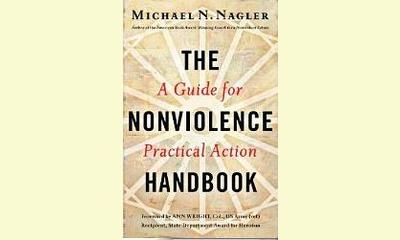|
|
The Nonviolence Handbook: A book review
un article par David Swanson (abridged)
Michael Nagler has just published The Nonviolence
Handbook: A Guide for Practical Action, a quick
book to read and a long one to digest, a book
that's rich in a way that people of a very
different inclination bizarrely imagine Sun Tzu's
to be. That is, rather than a collection of
misguided platitudes, this book proposes what
still remains a radically different way of
thinking, a habit of living that is not in our
air. In fact, Nagler's first piece of advice is to
avoid the airwaves, turn off the television, opt
out of the relentless normalization of violence.

click on photo to enlarge
We don't need the art of war applied to a peace
movement. We need the art of satyagraha applied to
the movement for a peaceful, just, free, and
sustainable world. This means we have to stop
trying to defeat the Military Industrial Complex
(how's that been working out?) and start working
to replace it and to convert the people who make
up its parts to new behaviors that are better for
them as well as for us. . .
Nagler's examples highlight the importance of
knowing what is negotiable, what should be
compromised, and what must not be; what is
substantive and what symbolic; when a movement is
ready to escalate its nonviolence and when it is
too soon or too late; and when (always?) not to
tack on new demands in the middle of a campaign. .
.
Nagler outlines obstructive and constructive
actions, citing Gandhi's efforts in India and the
first Intifada as examples of combining the two.
The Landless Worker Movement in Brazil uses
constructive nonviolence, while the Arab Spring
used obstructive. Ideally, Nagler thinks, a
movement should begin with constructive projects
and then add obstruction. The Occupy Movement has
gone in the opposite direction, developing aid for
storm victims and banking victims after protests
were driven out of public squares. The potential
for change, Nagler believes, lies in the
possibility of Occupy or another movement
combining the two approaches. . .
Nagler sees growing success and even greater
potential for nonviolent action done wisely and
strategically, and points out the extent to which
violence remains the default approach of our
government. And the case Nagler makes is made
strong and credible by his extensive knowledge of
nonviolent campaigns engaged in around the world
over the past several decades. Nagler looks
helpfully at successes, failures, and partial
successes to draw out the lessons we need moving
forward. I'm tempted to write a review of this
book nearly as long as or even longer than the
book itself, but believe it might be most helpful
simply to say this:
Trust me. Buy this book. Carry it with you.
|








|
DISCUSSION
Question(s) liée(s) à cet article:
What are the most important books about the culture of peace?,
* * * * *
Commentaire le plus récent:
Johan Galtung is indeed the most perceptive peace researcher of our time.
Not only did he predict the fall of the Soviet Union quite precisely, but he has also predicted the fall of the American empire. Here are excerpts from his 2004 article,
On the Coming Decline and Fall of the US Empire
The prediction of the decline and fall of the US Empire is based on the synergy of 14 contradictions, and the time span for the contradictions to work their way through decline to fall was estimated at 25 years in the year 2000. There are more contradictions because the US Empire is more complex, and the time span is longer also because it is more sophisticated. After the first months of President George W. Bush (selected) the time span was reduced to 20 years because of the way in which he sharpened so many of the contradictions posited the year before, and because his extreme singlemindedness made him blind to the negative, complex synergies. . . .
Here is the list of 14 contradictions posited in 2000:
I. Economic Contradictions(US led system WB/IMF/WTO NYSE Pentagon)
1. between growth and distribution: overproduction relative to demand, 1.4 billion below $ 1/day, 100.000 die/day, 1/4 of hunger
2. between productive and finance economy (currency, stocks,bonds) overvalued, hence crashes, unemployment, contract work
3. between production/distribution/consumption and nature: ecocrisis, depletion/pollution, global warming
II. Military Contradictions (US led system NATO/TIAP/USA-Japan)
4. between US state terrorism and terrorism: Blowback
5. between US and allies (except UK, D, Japan), saying enough
6. between US hegemony in Eurasia and the Russia India China triangle, with 40% of humanity
7. between US led NATO and EU army: The Tindemans follow-up
III. Political Contradictions (US exceptionalism under God)
8. between USA and the UN: The UN hitting back
9. between USA and the EU: vying for Orthodox/Muslim support
IV. Cultural Contradictions (US triumphant plebeian culture)
10. between US Judeo-Christianity and Islam (25% of humanity; UNSC nucleus has four Christian and none of the 56 Muslim countries).
11. between US and the oldest civilizations (Chinese, Indian, Mesopotamian, Aztec/Inca/Maya)
12. between US and European elite culture: France, Germany, etc.
V. Social Contradictions (US led world elites vs the rest: World Economic Forum, Davos vs World Social Forum, Porto Alegre)
13. between state corporate elites and working classes of unemployed and contract workers. The middle classes?
14. between older generation and youth: Seattle, Washington, Praha, Genova and ever younger youth. The middle generation?
15. To this could be added: between myth and reality.

|
|









